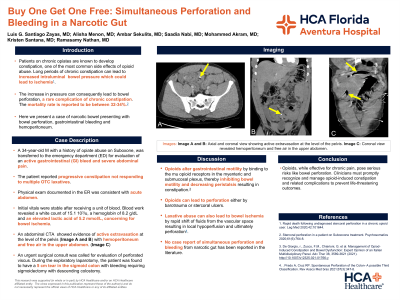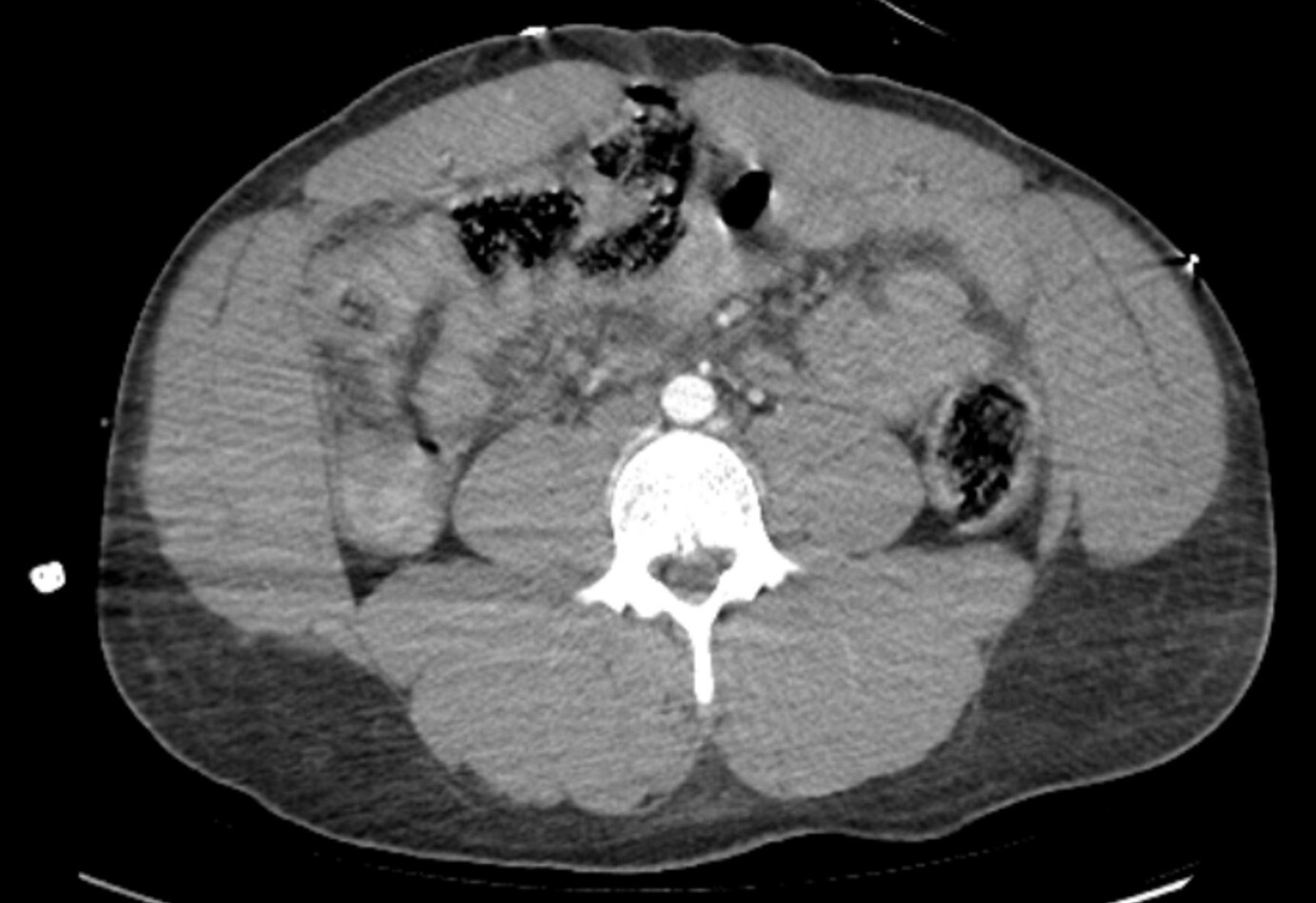Tuesday Poster Session
Category: GI Bleeding
P4238 - Buy One Get One Free: Simultaneous Perforation and Bleeding in a Narcotic Gut
Tuesday, October 29, 2024
10:30 AM - 4:00 PM ET
Location: Exhibit Hall E

Has Audio
- LS
Luis G. Santiago Zayas, MD
Aventura Hospital
Aventura, FL
Presenting Author(s)
Luis G. Santiago Zayas, MD1, Alisha Menon, MD1, Ambar Sekulits, MD2, Mohammed Akram, MD1, Kristen Santana, MD1, Ramasamy Nathan, MD1
1Aventura Hospital, Aventura, FL; 2Aventura Hospital, Dania Beach, FL
Introduction: Patients on chronic opiates are known to develop constipation, one of the most common side effects of opioid abuse. Long periods of chronic constipation can lead to increased intraluminal bowel pressure which could lead to ischemia. The increase in pressure can consequently lead to bowel perforation, a rare complication of chronic constipation. The mortality rate is reported to be between 32-34%. Here we present a case of narcotic bowel presenting with bowel perforation, gastrointestinal bleeding and hemoperitoneum.
Case Description/Methods: A 34-year-old male with a history of opiate abuse on Suboxone, was transferred to the emergency department (ED) for evaluation of an active gastrointestinal (GI) bleed and severe abdominal pain. Patient complained of a sudden onset of abdominal pain radiating down to his testicles and with passage of bright red blood per rectum. The patient reported progressive constipation not responding to multiple over the counter (OTC) laxatives. Physical exam documented in the ER was consistent with acute abdomen. Initial vitals were stable after receiving a unit of blood in the other institution. Blood work revealed a white count of 15.1 103/u, a hemoglobin of 8.2 g/dL and an elevated lactic acid of 5.2 mmol/L, concerning for bowel ischemia. An abdominal CT angiography showed evidence of active extravasation at the level of the pelvis with hemoperitoneum and free air in the upper abdomen. An urgent surgical consult was called for evaluation of perforated viscus. During the exploratory laparotomy, the patient was found to have a 5 cm tear in the sigmoid colon with bleeding requiring sigmoidectomy with descending colostomy. Patient recovered well after surgery and was discharged home.
Discussion: Opioids alter gastrointestinal motility by binding to the mu opioid receptors in the myenteric and submucosal plexus, thereby inhibiting bowel motility and decreasing peristalsis resulting in constipation. Opioids can lead to perforation either by barotrauma or stercoral ulcers. Laxative abuse can also lead to bowel ischemia by rapid shift of fluids from the vascular space resulting in local hypoperfusion and ultimately perforation. No case report of simultaneous perforation and bleeding from narcotic gut has been reported in the literature. Clinicians should be vigilant about the diagnosis and management of opioid induced constipation.

Disclosures:
Luis G. Santiago Zayas, MD1, Alisha Menon, MD1, Ambar Sekulits, MD2, Mohammed Akram, MD1, Kristen Santana, MD1, Ramasamy Nathan, MD1. P4238 - Buy One Get One Free: Simultaneous Perforation and Bleeding in a Narcotic Gut, ACG 2024 Annual Scientific Meeting Abstracts. Philadelphia, PA: American College of Gastroenterology.
1Aventura Hospital, Aventura, FL; 2Aventura Hospital, Dania Beach, FL
Introduction: Patients on chronic opiates are known to develop constipation, one of the most common side effects of opioid abuse. Long periods of chronic constipation can lead to increased intraluminal bowel pressure which could lead to ischemia. The increase in pressure can consequently lead to bowel perforation, a rare complication of chronic constipation. The mortality rate is reported to be between 32-34%. Here we present a case of narcotic bowel presenting with bowel perforation, gastrointestinal bleeding and hemoperitoneum.
Case Description/Methods: A 34-year-old male with a history of opiate abuse on Suboxone, was transferred to the emergency department (ED) for evaluation of an active gastrointestinal (GI) bleed and severe abdominal pain. Patient complained of a sudden onset of abdominal pain radiating down to his testicles and with passage of bright red blood per rectum. The patient reported progressive constipation not responding to multiple over the counter (OTC) laxatives. Physical exam documented in the ER was consistent with acute abdomen. Initial vitals were stable after receiving a unit of blood in the other institution. Blood work revealed a white count of 15.1 103/u, a hemoglobin of 8.2 g/dL and an elevated lactic acid of 5.2 mmol/L, concerning for bowel ischemia. An abdominal CT angiography showed evidence of active extravasation at the level of the pelvis with hemoperitoneum and free air in the upper abdomen. An urgent surgical consult was called for evaluation of perforated viscus. During the exploratory laparotomy, the patient was found to have a 5 cm tear in the sigmoid colon with bleeding requiring sigmoidectomy with descending colostomy. Patient recovered well after surgery and was discharged home.
Discussion: Opioids alter gastrointestinal motility by binding to the mu opioid receptors in the myenteric and submucosal plexus, thereby inhibiting bowel motility and decreasing peristalsis resulting in constipation. Opioids can lead to perforation either by barotrauma or stercoral ulcers. Laxative abuse can also lead to bowel ischemia by rapid shift of fluids from the vascular space resulting in local hypoperfusion and ultimately perforation. No case report of simultaneous perforation and bleeding from narcotic gut has been reported in the literature. Clinicians should be vigilant about the diagnosis and management of opioid induced constipation.

Figure: CT angiography scan of the abdomen, axial view, showing a small-volume intraperitoneal free air. Findings suggestive of a colonic perforation.
Disclosures:
Luis Santiago Zayas indicated no relevant financial relationships.
Alisha Menon indicated no relevant financial relationships.
Ambar Sekulits indicated no relevant financial relationships.
Mohammed Akram indicated no relevant financial relationships.
Kristen Santana indicated no relevant financial relationships.
Ramasamy Nathan indicated no relevant financial relationships.
Luis G. Santiago Zayas, MD1, Alisha Menon, MD1, Ambar Sekulits, MD2, Mohammed Akram, MD1, Kristen Santana, MD1, Ramasamy Nathan, MD1. P4238 - Buy One Get One Free: Simultaneous Perforation and Bleeding in a Narcotic Gut, ACG 2024 Annual Scientific Meeting Abstracts. Philadelphia, PA: American College of Gastroenterology.
